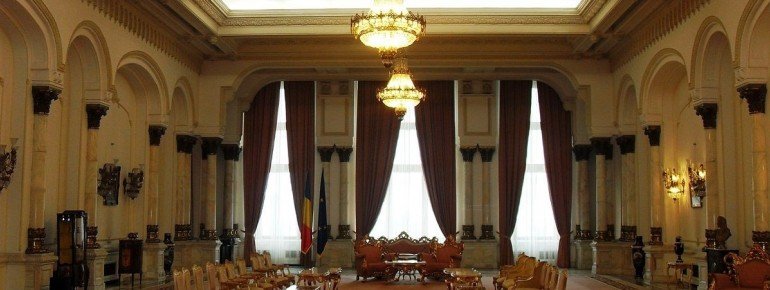Contents
Description

Holding the record on many levels
If you happen to be in Romania's capital city, there's no way you can manage to skip paying a visit to the Palace of Parliament in Bucharest. Not only is the palace highly impressive, optically speaking, but also a major hub of the city, seen from a historical perspective. Considering this, the edifice breaks several records at once. It is the largest building in Europe with encompassing a surface of 365,000 m² (36.5 ha). And what is more, it remains the second-largest building in the world after the Pentagon. Another noteworthy fact is equally impressive: the Palace of Parliament is the heaviest building in the world as it consists of several tons of steel, bronze, marble and crystal. Therefore, it does not come as a surprise that it holds the record for the most expensive building in the world – worth an estimated 4 trillion US-$.
Extended tour through the Palace of Parliament
The parliament building is still used as a venue for political debates. Nevertheless, guided tours for tourists are allowed and do take place. You are taken through the High Halls and ballrooms of this splendid edifice and at the same time you'll be embarking on a journey through time while gaining an insight into Romania's past. Participating in a tour, you have the chance to see several galleries of honour and even a theatre. In order to get a better perspective of the parliament building, the tour also takes you to the front balcony, which you can have a fantastic view on the 3 km (1.9 mi) long Bulevardul Unirii, the “Boulevard of Unification”. Should you be in the mood for more, you may as well pop in to the National Museum of Modern Art which you'll find in the back part of the building.
Historical Information
Ceaușescu's legacy
The construction work for the Palace of Parliament as it stands today began under the neo-Stalinist rule of Nicolae Ceaușescu in 1984, then known as “The House of the People” or the “House of Victory”. In his time of rule, Ceaușescu was generally perceived as a charismatic leader, but with the years passing he more and more turned to a tyrant with a strong penchant for megalomania. And the Palace of Parliament is mere evidence for his megalomaniac tendencies. As the edifice was to become the symbol and landmark of Ceaușescu's power, the project of designing the Palace of Parliament was subject to a tendering procedure, won by 26-year old student Anca Petrescu. She was in charge for the construction of the house of parliament during the entire period until its date of completion.
A turn in Romania's history
The significance of the Palace of Parliament could already be seen in the pre-phase of the construction. In total, there were 40,000 blocks of flats, churches and other buildings relocated and knocked down. These radical measures were seen to be indispensable for realising the project. Construction work, however, was carried out under massive protests of the Romanian people which were barely considered by those in charge. This was the exact reason for the population to ironically call Romania's house of parliament “House of Victory over the People”. It was henceforth regarded as a sheer demonstration of power and suppression of the people. The man in power, Ceaușescu, increasingly got under pressure until he was toppled and executed, following the latest riots.
Bucharest's political centre
After the end of Ceaușescus regime, heavy discussions were led in respect of how to use the splendid and sprawling building in the future. As many Romanians still associated the building with the Socialist regime, the project attracted vocal criticism. Many wanted the entire building knocked down as it seemed reminiscent of the Socialist period which, in collective memory, is remembered as time of oppression. In 1991, though, it was decided to keep the edifice as it was and thus labelled it “Palace of Parliament”, the allegedly most neutral way possible. Lots of reconstruction work had been done since 1997, allowing the Romanian parliament to reside here. In order to complement the political significance of the building, the senate moved in here, too, in 2005. Three years later, in 2008, the NATO Parliamentary Assemblycame together. The construction is up to this very day used as central venue for meetings and conferences.
How to get there
By car
Coming from the direction of Pitești
You first take the DN65, driving out of town, then directly change onto DN7. You stay on the Centura Pitești which you follow for the next 112 km (70 mi) and leave again via a right-handed bend onto the Bulevardul Profesor Doctor Gheorghe Marinescu. Carrying on the Bulevardul Eroii Sanitari, you eventually get on the Splaiul Independenței to finally arrive at the Palace of Parliament in Bucharest.
Coming from the direction of Constanța
You take the DN3, driving out of town, and use the slip road taking you onto A4. It directly leads onto the A2 (Autostrada Soarelui). Follow the road for about 210 km (130 mi). Approaching the outskirts of Bucharest, you take a right turn and change onto Bulevardul Burebista, leading via a roundabout to the Bulevardul Unirii, which is the direct way to the Palace of Parliament.
Coming from the direction of Ploiești
You leave the city driving southwards on the Bulevardul București. After only a short time, you change onto DN1 and follow the road for the next 48 km (30 mi). If you are on the verge of reaching the outskirts of Bucharest, you change onto Șoseaua Pavel Dimitrievici Kiseleff, which takes you, via the Strada Buzești, to the Palace of Parliament.
Arriving at the Palace of Parliament, you find an underground car park with a capacity for 20,000 vehicles.
By public transport
You can comfortably get to Bucharest by train. Romania's capital has an international train station which sees many trains arriving from and leaving for Romanian cities such as Timișoara or Constanta. Bucharest can also comfortably be reached from abroad as trains arriving from places like Vienna or Istanbul take you straight to the city centre.
Travelling from Germany, there are plenty of tour coach operators taking you to Bucharest.
By plane
The Otopeni Henri Coandă International Airport is your flight destination if you wish to travel to Bucharest by plane. All over Europe, you have frequent flights operating between Romania's capital and other European metropolises. Once at the airport, you just need to hop on bus line 783 to get to the town centre.




















